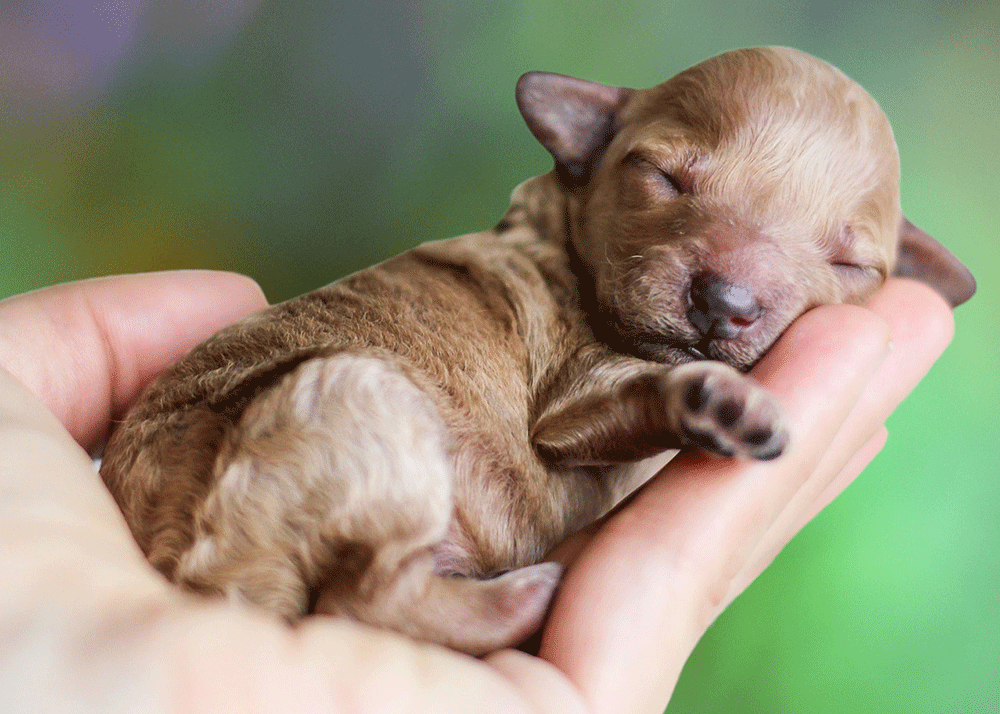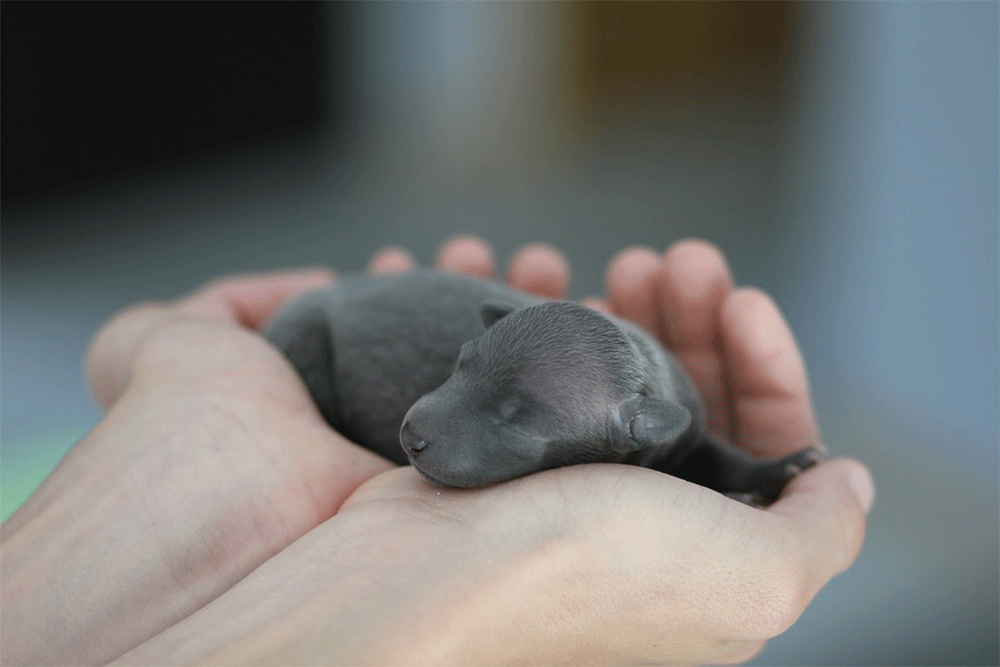Everyone knows that when babies are born they have an umbilical cord that is attached to the placenta, but do dogs have the same? Dogs are quite similar to humans when it comes to reproduction, but how similar is the process?
You might have noticed what you think is a belly button on your dog’s stomach, and naturally this led you to wonder if they had an umbilical cord when they were born. Or, it could be something that crossed your mind late one night, and now you are dying to know the answer.
If you have ever wondered if dogs are born with an umbilical cord, then you have come to the right place, as this is something that we are going to explain to you in this article. We are going to look at whether dogs have umbilical cords and belly buttons, and if so, why. To find out more about this, just keep reading.

Do Dogs Have Belly Buttons?
Yes, dogs do have belly buttons. In fact, all mammals will have belly buttons as part of their growth process that takes place before they have been born. The only mammals that don’t have a belly button are marsupials.
A belly button is left behind when the umbilical cord is broken after the puppy has been born, and this is what is used when the puppy is still in the womb of the mother. So, the belly button is simply the scarring that is left behind from when they were connected to the umbilical cord, which is no longer needed once they have been born. The scarring is much more minimal than with a human, which is why dogs have smaller and less noticeable belly buttons.
Where is My Dog’s Belly Button?
Finding your dog’s belly button can actually prove to be more difficult that you might have thought. The reasons why it can be a challenge to find the belly button of your dog are that:
- The belly button is simply a scar, and with dogs, this is a scar that heals really quickly and that is quite small in size
- Almost all dog belly buttons are flat, rather than in or out like us humans
- Dogs have fur on their stomachs, which can also make the belly button less visible
Does a Dog Have an Umbilical Cord When They Are Born?
Yes, a dog will have an umbilical cord when they are born, and this is what connects them to their mother’s placenta when they are inside the womb. When the puppy is born, the mother will usually chew through the umbilical cord, which will leave behind a small scar that is referred to as the belly button.
The umbilical cord has an important function inside of the womb, but it is no longer needed when the puppy is born. This is why it is removed, and this is the point where the puppy gains their physical independence from the mother. However, they will still rely on the mother for care until they get old enough to look after themselves.
What Does a Dog’s Umbilical Cord Do?
All dogs will be born with an umbilical cord, and this has a really important function. The pups will develop and grow inside the mother, and they will feed and receive oxygen through a specialized embryonic organ, which is called the umbilical cord. This cord is attached to the mother’s placenta.
Once the puppy has been born there is no use for the umbilical cord as they will feed from the mother externally. This is when the mother will chew through the umbilical cord, or you may need to cut it yourself in certain circumstances. A small piece will be left behind, which after time, will heal and wither away. Over time, a scar will form where the umbilical cord used to be attached, and this is what we call the belly button.
What is a Dog’s Umbilical Cord Connected to?
The umbilical cord of a dog will centrally connect in the middle of the puppy’s abdomen, just below the ribs. This is then where you will be able to find the belly button after the umbilical cord has been removed, and it has all healed up.
The belly button of a dog can be in all different shapes and sizes, just like with humans, and they can also get what is commonly referred to as innies and outies. However, the majority of dog’s belly buttons will be flat and much less noticeable. As we have previously mentioned, dog belly buttons are difficult to find due to their fur, and they will likely look like a small scar that is slightly raised from the skin and in the shape of an oval.
Sometimes, these belly buttons get mistaken for another nipple, but this is not the case. While they can sometimes be similar in appearance, they are often much flatter. You can find the belly button by feeling under the ribs for something that feels a bit more firm than the rest of their skin.
Should I Worry if My Dog’s Belly Button is Protruding?
As you now know, it is completely normal for a dog’s belly button to be small and flat and obscured by fur. More often than not, people don’t even notice that their dog does have a belly button unless they are looking really closely. Their umbilical cord is quite small, which means that their scar will be much smaller too.
If you have noticed that your dog has a protruding belly button, then there could be a cause for concern, and it is important to be aware of what this could mean for your dog. Due to the fact that a belly button typically goes unnoticed, it could be worrying if it is sticking out.
If you have noticed that your dog’s belly button is either sticking out or swollen, then it could mean that they have developed a condition that is called an umbilical hernia. This can occur when the contents of the abdomen becomes trapped in the belly button, which can be fatal if it is left untreated. If you notice any swelling around the belly button, you should make an appointment to see your vet, so they can rule out any potential issues or provide you with a diagnosis.
Should You Cut a Dog’s Umbilical Cord When They Are Born?
Once your puppy has been born, the umbilical cord is still going to be attached to the placenta, and this will come out of the mother once the puppy is born on the next contraction. Upon birth, the puppy will still be attached to the umbilical cord, which is attached to the placenta, and this line will need to be broken.
Usually, the mother will bite at the umbilical cord to sever the connection from the puppy to the placenta. This is a natural occurrence, and the mother will know exactly what she needs to do. However, if for some reason the mother does not do this, someone will need to step in to cut the umbilical cord a few inches up from the puppy’s belly. After this has been done, what is left of the umbilical cord will drop off after a few days, leaving behind a belly button.
How Do You Cut a Puppy’s Umbilical Cord?

If you are with a vet or someone with experience with this situation, they will be able to step in and cut the cord. Alternatively, if this has happened really quickly at home, then you will need to step in and cut the cord if the mother does not do so.
You will need to use sterilized scissors for this process, and you should cut around an inch up from the puppy’s belly. You will then need to tie off the cord with either thread or dental floss around ¼ to ½ an inch from the puppy’s belly. When you are cutting, you should crush the cord, rather than making a clean cut, as this will lessen the amount of bleeding. Once you have tied it off, you can dip the end of it in a shallow dish with an antiseptic solution.
Will My Dog Eat the Umbilical Cord?
You might be wondering what happens to the umbilical cord, and this is something that can definitely happen. It might not always be the case, but if the mother does eat the umbilical cord, you should know that it is perfectly normal for her to do so.
Usually, when the mother has chewed through the umbilical cord to free the puppy, she will eat the placenta and the remains of the umbilical cord, and this placenta is full of nutrients, so it is actually good for her. This might not be the case for you, but it does happen.
Some of the reasons why the mother might eat the umbilical cord are that:
- It encourages the production of milk and speeds up birth.
- It is a way of cleaning up the den after the birth
- They can get a nutritious source of food after giving birth
- It helps the uterus return to its pre-pregnancy state.
There are some people and even experts that would say that this is unnecessary for domesticated dogs, but it will not harm them to eat the placenta. In fact, some people even choose to eat the placenta after giving birth. When you put it that way, it doesn’t seem so strange at all. This is something that would have been natural for a dog in the wild, so there is no reason why your dog can’t do the same thing.
